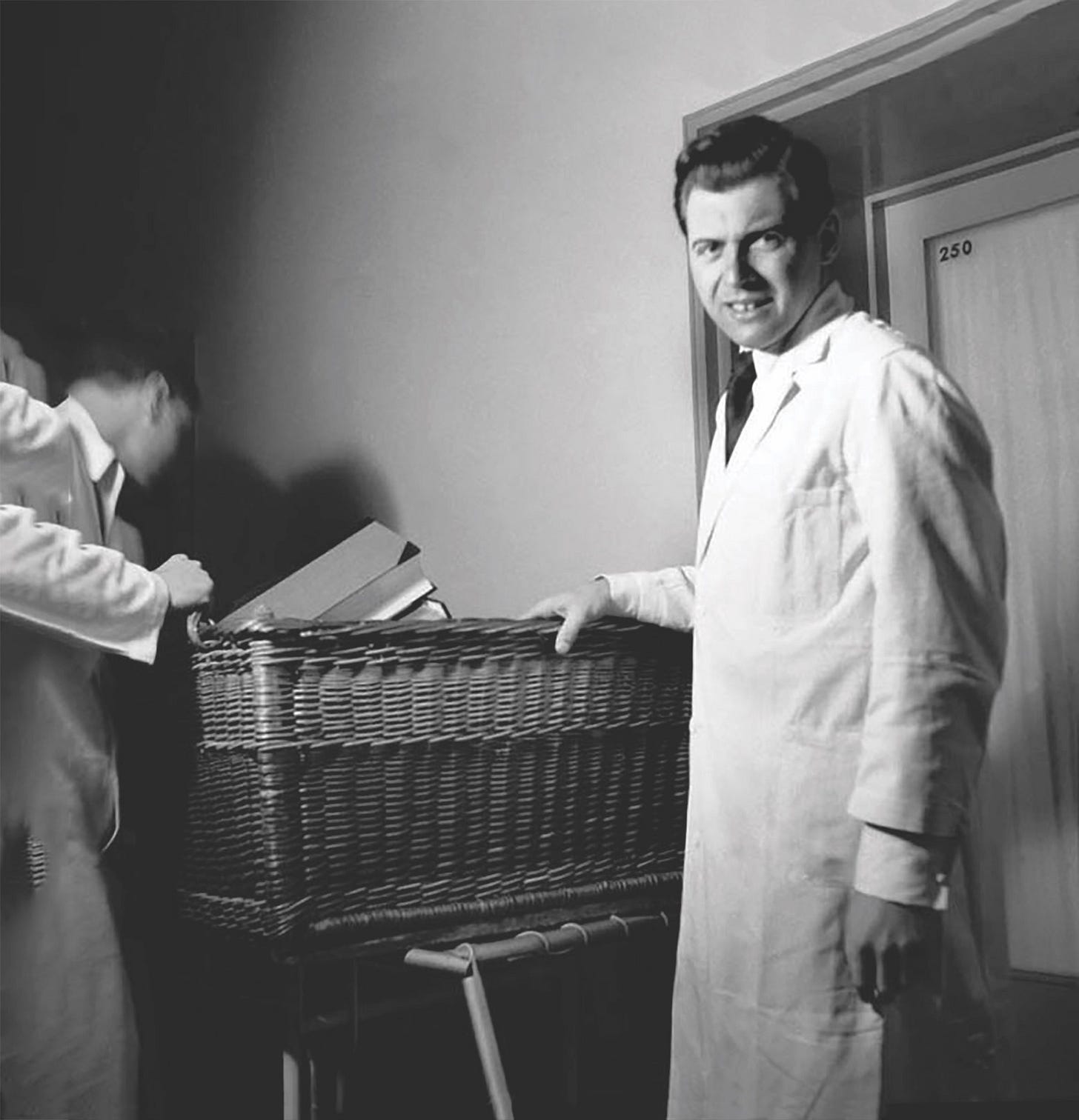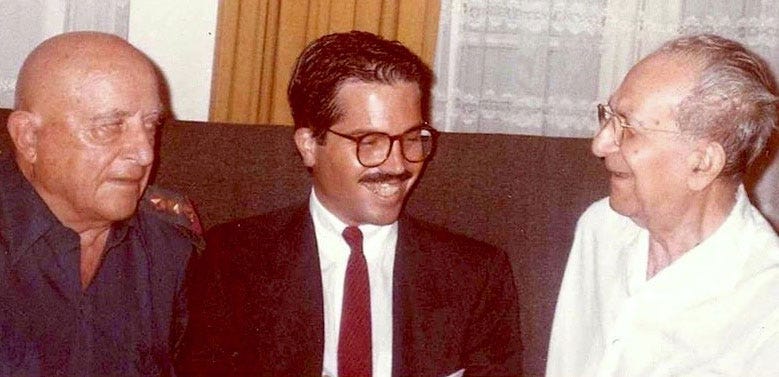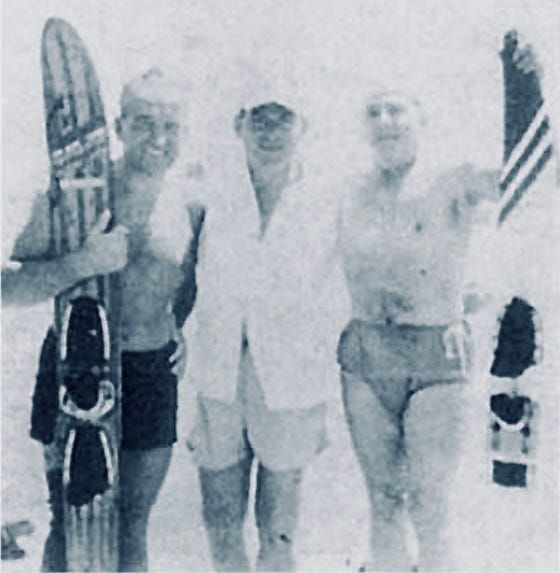My 40-year Hunt for Josef Mengele's Auschwitz Lab Notes

For 40 years I have searched for a briefcase stuffed with medical notes and lab specimens that belonged to Auschwitz's Angel of Death, Dr. Josef Mengele.
It began unexpectedly while I was practicing law in 1981 in New York. I had agreed to a pro bono representation of Marc Berkowitz, a surviving twin of Mengele's camp experiments. Berkowitz, and his twin sister, Francesca, wanted the German government or the Mengele family to pay for the costly medical care that they – and about 100 other surviving twins – incurred as a result of Mengele’s barbarism. Modern-day doctors were frustrated in treating the twins’ chronic ailments because there were no records of the compounds and drugs Mengele had administered in his mad efforts to create a "superior race."
Berkowitz and other survivors were confident that Mengele had kept the records they needed. Dr. Martina Puzyna, an inmate anthropologist forced to serve as one of Mengele's camp assistants, told postwar investigators that when Mengele fled Auschwitz on January 17, 1945, he "took all my papers, put them into two boxes, and had them taken outside to a waiting car."
I thought that Berkowitz's quest to find out more about the torture he and other twins endured at Auschwitz was a simple pro bono case on which I would spend a few hours a week. It instead became an all-consuming passion.
It took until the summer of 1983 before I picked up the first lead about what might have happened to Mengele’s medical notes. Herbert John, a tall, rail thin German journalist, had spent more than twenty years as a roving reporter in South America for Der Spiegel, one of Germany's leading newsweeklies. Ladislas Farago, the bestselling author of Patton and The Game of the Foxes, called John "one of the most resourceful and courageous reporters on the trail of fugitive Nazis."
John told me how he had penetrated Die Spinne (The Spider), a real-life Odessa File in which an underground organization supported Third Reich fugitives to stay one step ahead of Nazi hunters. He regaled me with tales about a German doctor in Paraguay who had met Mengele, as well as a Buenos Aires-based acquaintance who claimed to know the whereabouts of an attaché case that Mengele had left behind when he had fled Argentina to move to Paraguay around 1960. That case, claimed John, contained "notes about his camp work." John said he could broker a deal for the attaché for "about $100,000. That should do it.”
I was hopeful but skeptical. So began my due diligence into the bona fides of the fast-talking German who dangled the promise of a breakthrough on the hunt for Mengele’s lab papers. During a 1984 research trip to Argentina, Paraguay and Brazil, I encountered a couple of dozen people who claimed a role in or knowledge about the neo-Nazi underworld. Most passed along exaggerated tales in the hope of cashing in on the desperation of victims. It was, I discovered, part of a burgeoning market for fake Nazi memorabilia as well as "latest tips" for sale. Those false leads sometimes led to hotels or halfway houses run by conmen: "The man you are looking for just left with a group of Germans" was the common refrain.
Facts, I learned, did not deter those who wanted to profit from Holocaust victims. Erich Erdstein, an Austrian-born soldier of fortune, was typical. He boasted that he had tracked down Mengele and shot him to death in the 1960s. Erdstein even wrote a slim book about his adventures. When I later confronted him with the incontrovertible evidence that Mengele was alive, he shrugged his shoulders: "I guess I must have killed the wrong man."
Wilfred von Oven, a one-time secretary to Nazi propaganda chief, Josef Goebbels, had moved to Buenos Aires after the war and edited a neo-Nazi newspaper. When I got in touch with him, he claimed to know nothing about Mengele. He did, however, have a “lead” that could possibly take me to the pistol that Captain Hans Wilhelm Langsdorff used in 1939 to take his own life in a Buenos Aires hotel room after he had scuttled his battleship, the Graf Spee, in Uruguay. I soon learned that there was at least half a dozen such Mauser pistols that were for sale to “collectors.”
It did not take long before I lost faith in Herbert John. He swore that Martin Bormann, Hitler's powerful secretary, was living in Bolivia, although most historians believe the Soviets killed Bormann when he was trying to escape Berlin in the final days of the war. John, in his trademark rumpled tan suit, would with great flair pull from his jacket pocket a tiny black and white photograph of some men, one of whom he said was Bormann in 1958 leaving a Rotary Club meeting in La Paz. John was not bothered that the picture was so fuzzy and grainy that it was impossible to identify any of the men. John was a good salesman. He talked about the snapshot in whispers and spun a riveting tale of how he obtained it through Hans Rudel, Hitler's most decorated wartime pilot. Rudel, who had continued flying wartime combat missions even after he lost a leg, was a hero in the loose-knit Fourth Reich and Rudel boasted of helping Mengele stay free after the war.
Almost every new clue, however, that John offered about Mengele, was available only at a price. As for the few he passed along for free invariably ended up as dead ends.

The possibility of a Mengele briefcase stuffed with notes from Auschwitz remained an unproven rumor until 1985. That was when German police executed a search warrant on the home of a Mengele childhood friend. Hidden behind a large dresser, they found handwritten postwar letters from Mengele to his family. The letters identified a German-Brazilian family that had protected the fugitive doctor. Brazilian investigators who interrogated that family were stunned to discover that the fugitive doctor had died five years earlier while swimming in the ocean at a coastal resort outside Sao Paulo. A team of internationally recognized forensic pathologists examined the bones recovered from a makeshift grave and concluded unanimously that the skeleton was indeed Mengele.
In Munich, Mengele's only son Rolf, a lawyer, turned over thousands of pages of his father's postwar letters and diaries to Bunte, a German magazine. In 1983, one of Bunte's competitors, Stern, had been mortified after it published “Hitler diaries” that turned out to be fake. So Bunte assembled a team of historians, handwriting experts and document authenticators, to determine whether the Mengele archive was authentic. Because of my extensive files and research, Bunte invited me to join that panel.
During weeks in Munich I questioned Rolf Mengele and poured over his father's postwar writings (Rolf Mengele later allowed me and my British co-author, John Ware, to use his father's private papers in our 1986 biography, Mengele: The Complete Story).
And it was in a later meeting in New York with me, Rolf, and my wife and research partner Patricia Posner, that Rolf mentioned how a couple of pharmacists had helped his father in the early days after his escape from Auschwitz. That conversation led Patricia to write The Pharmacist of Auschwitz, an international bestseller in 17 languages. (It is the first nonfiction account of the pharmacist who ran the dispensary at the largest Nazi death camp).
It was in Mengele’s handwritten postwar diaries that I discovered the confirmation that he had indeed fled Auschwitz with medical notes. Mengele recounted his retreat westward during the spring of 1945 and the friendship he made with an unnamed German nurse who was also running from the advancing Russian army. Mengele knew that if he was captured, his medical notes would immediately unmask him as a concentration camp doctor. So, he took the risk of entrusting his prized Auschwitz records with the nurse.
It was a wise move. I uncovered through Freedom of Information requests that Mengele was Mengele was captured and released twice by American troops in the months after the war. They did not have him on a wanted list and in one instance did not even know he was an SS officer. Meanwhile, the nurse had made it safely back to Gera, a small town in the Russian zone. By July, six months after Mengele had fled Auschwitz, he made a perilous three-week journey that he described as "a crazy undertaking." He risked capture by the Russians to travel to Gera to retrieve his medical papers.
Mengele – who lived under an alias on a small farm in southern Germany – does not mention his Auschwitz papers again until 1949 when he prepared to flee Europe for the safe haven of Argentina. In his diaries, a person he calls Erwin met him at an Italian inn near the Alps. Erwin brought along cash for the escape to South America and also, according to Mengele, "a small suitcase filled with scientific specimens." Rolf Mengele later confided to me that Erwin was Hans Sedlmeier, one of Mengele's closest friends and the sales manager at the family's agricultural equipment firm. It had been Sedlmeier’s home at which German police had served the search warrant that found Mengele’s fugitive correspondence.
On August 26, 1949, Mengele passed through Argentine customs at the port of Buenos Aires. In his own account, Mengele writes that an inquisitive immigration agent asked what was in the suitcase that contained his specimens. Mengele told him, "Biological notes." Not satisfied, the agent called for the medical doctor assigned to the port but luckily for Mengele, that physician did not read German. After flipping quickly through the documents, he waved Mengele through.
That was the last time Mengele mentions the Auschwitz papers in his diaries. Did he destroy them as the hunt to find him picked up pace a decade later? Did he bury them in some unknown hideaway, possibly undiscovered to this day? Or did he pass it along to one of his South American protectors?
Mengele's son Rolf assisted me over the years in hunting for the missing camp notes. He questioned the two South American families who had helped his father stay one step ahead of his pursuers. Both denied ever seeing any such documents. The same denials came from Rolf's aunt and a cousin who had lived with Mengele for a few years in Argentina. And I have had no success, despite combing through reams of Nazi party files and records, in identifying the nurse from Gera with whom Mengele had originally entrusted the papers.
At different times over the years, I have had promising leads that led nowhere. Dr. Otto Biss, the German doctor who lived in Asunción and likely knew Mengele when he was hiding in Paraguay for a couple of years in the early 1960s, told me that Mengele had left a file of papers with the owners of the Hotel Tirol, deep in the rain forest, near the Argentine border. I visited and stayed there but no one admitted that Mengele had used it as a hideout much less as storage for his Auschwitz papers.
Another time, I ended up in the small Paraguayan town of Pedro Juan Caballero, in a remote province near Brazil. The German family I tracked down denied meeting or knowing anyone who fit Mengele’s description.
On yet another occasion, I had a lead that Hans Rudel, Hitler’s most decorated pilot, had a private locker in the basement of a sprawling German restaurant behind Asuncion’s Guarani Hotel. I had a picture of Rudel (with his artificial leg) on a water-skiing holiday with a Paraguayan colonel, Alejandro von Eckstein. The latter was Mengele’s co-sponsor for citizenship in Paraguay, and my unofficial guide when I visited that country in 1984.

The closest I got to the restaurant basement was a staircase blocked by a heavyset self-described “security officer” who ushered me outside and said that he would call the police if I returned.
In May 2015, I got a note from an American living in Berlin who claimed to know that Mengele’s briefcase ended up in the care of a Franciscan priest in Buenos Aires. It took a month to determine that the priest was long dead and had no family. The parish where he served briefly in Argentina in the 1950s had been demolished twenty years ago. Again, only rumors and a cold trail. It took me until the summer of 2024 to find a priest who had served in the same Argentine seminary. He remembered his ethnic German colleague as alway willing to help “German refugees who had left Europe” after World War II, but knew nothing about a missing briefcase.
After all these years, I have not lost my zeal in finding Josef Mengele’s missing Auschwitz papers. Will I succeed? I have no idea, but I have no doubt my hunt will continue.




Fascinating…..how great would it be to find that briefcase!?!?
Fascinating!!! Thank you for sharing.